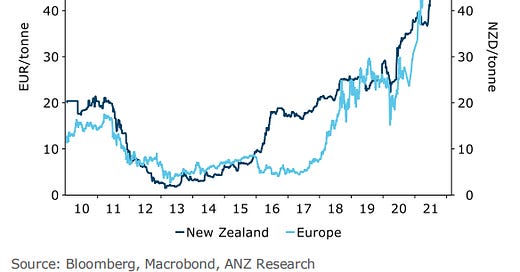In late February I reposted an article from the Carbon Risk archives drawing attention to the lessons we should learn from the world’s first cap-and-trade system - the United States sulphur dioxide (SO2) allowance trading system.
The eventual demise of the SO2 market illustrates what happens when trust is absolutely and unequivocally lost. As I describe in the article, “the SO2 allowance trading system also offers a cautionary tale in the power of trust and the fine line that governments must tread if environmental markets are to be successful in achieving their objectives. The term I coined to make sense of this, ‘The Currency of Decarbonisation’, comes directly from reading the economic history of cap-and-trade markets and the SO2 market in particular.”
Policymakers in New Zealand would do well to head these lessons as they contemplate the future of their own emissions trading market.
As my article from 12 months ago illustrates, the price of carbon allowances in New Zealand (NZUs) increased from less than NZ$10 in 2015 to almost NZ$90 in early 2022. NZU prices fell sharply, as other carbon markets did after the Russian invasion of Ukraine, but then rebounded to set a record high of NZ$88.50 in November 2022.
However, over the next six months the NZU price has lost over 45% of its value, declining to below NZ$50 in the past week as the market lost confidence in the government commitment to its climate change targets.
The Climate Change Commission (CCC), an independent body tasked with advising the government on climate policy, had recommended a steep increase in carbon auction price settings to align with the country's climate goals. However, in what was seen as a blatant attempt to cool the market ahead of an election year, the government ignored the advice of the CCC.
They first decided to make more allowances available to the market in 2023 than the CCC recommended, meaning that the surplus NZUs available would not decline as rapidly as the market expected. Meanwhile, the cost containment reserve (CCR) trigger price was increased from NZ$70 to NZ$80.64, significantly lower than the CCC's recommendation of a two-tier price structure of NZ$171 and NZ$214. Finally, the government increased the auction reserve price from NZ$30 to NZ$33.06, but this was much lower than the NZ$60 recommended by the CCC.
The uncertainty is bad news for investors in New Zealand’s carbon market of course, but it is also likely to have an adverse impact on the investment decisions of the country’s largest emitters as well. As I describe in Better in than out: The worlds largest meat and dairy corporations are under pressure to cut greenhouse gas emissions a high price on emissions is starting to influence the decarbonisation strategies of the largest meat and livestock companies.
The risk that New Zealand’s government now confronts is that after meddling in their carbon market they have now put all of that investment at risk.
The New Zealand emissions trading scheme was launched in 2008 as part of the Kyoto Protocol. In a similar vein to the EU’s emissions trading scheme, it has seen some significant changes over that time.
In 2015 the New Zealand scheme transitioned to a domestic only market. However, it has only been since 2020 that the scheme has moved towards something that investors in Europe or California would recognise.
Every emissions trading scheme as a different name for their carbon allowances. Here, allowances are known as New Zealand Units (NZUs), and equate to 1 tonne of carbon dioxide equivalent. NZUs have specific vintages that relate to emissions in a particular year.
As in other carbon markets, the price of allowances in New Zealand have rocketed. Since the start of 2020, the price of NZUs has increased 3-fold to NZ$75, equivalent to almost €50.



